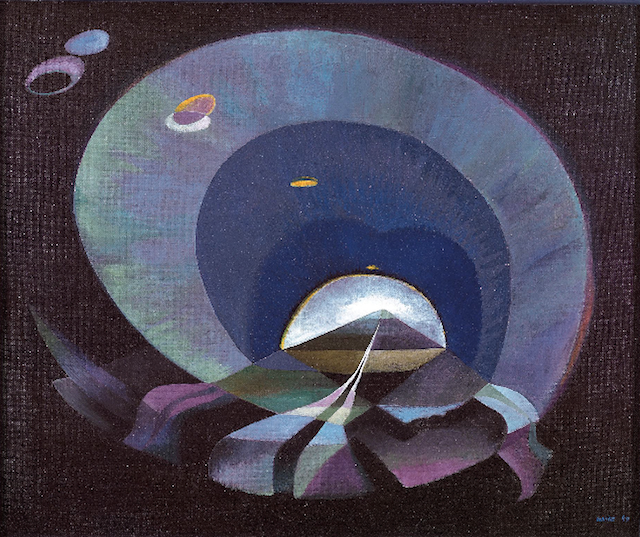
June Wayne, “The Tunnel” (1949). Oil on canvas. (all images from the June Wayne Collection, courtesy Louis Stern Fine Arts via the Pasadena Museum of California Art)
LOS ANGELES — June Wayne’s retrospective at the Pasadena Museum of California Art is a tightly curated, chronologically arranged exhibition of paintings, prints, tapestries, and video by a founder of the feminist art movement. Wayne, who died in 2011, was born and raised in Chicago, and moved to LA in 1942 after a three-year stint in New York City. She also founded the Tamarind Lithography Workshop, which she directed from 1960 to 1970. Work in this major retrospective was collected and plucked from different eras in her life, showcasing distinct periods in her artistic career including early social realist paintings from Mexico and Depression-era Chicago, visual awakenings upon her move to L.A., abstractions of the climate of Kafka (not to be confused with illustrations of Kafka’s stories), feminist consciousness-raising political works from the 1970s, and an ongoing fascination with the wonders of space and the future.
Wayne’s early work began with thick coats of paint and the rough stroke marks of social realism, both in Mexico and in Chicago, and only ceased when she moved to L.A., though her work never lost its obvious feminist overtones. Upon arriving in California, her focus initially shifted to her more abstract investigations into light and perspective. “The Target” (1951) and “The Tunnel” (1949) both peer into the elongated roads and tunnels that connect the sprawling place that make Los Angeles what it is. Around the same time, Wayne’s mind wandered into the depths of Kafka as seen in “The Cavern” (1948). In the catalogue for the exhibition, Wayne states that her Kafka images “ … partake of the climate of Kafka, the Kafkaesque world, where nothing is exactly as it seems to be, where everything and its opposite are somehow united.” It’s curious to note that Wayne first read Kafka as a teenager in Chicago; as an adult, she brought her Kafka texts with her to California. Her adolescent reliving, Kafka-inspired works were closely followed by Los Angeles-inspired imagery, suggesting a possible conceptual connection between her adolescence in Chicago and her fascination with time and space in L.A.; could it be that in both adolescence and L.A., “nothing is exactly as it seems to be, where everything and its opposite are somehow united”?
Read the full review here: http://hyperallergic.com/129722/june-waynes-farewell/



